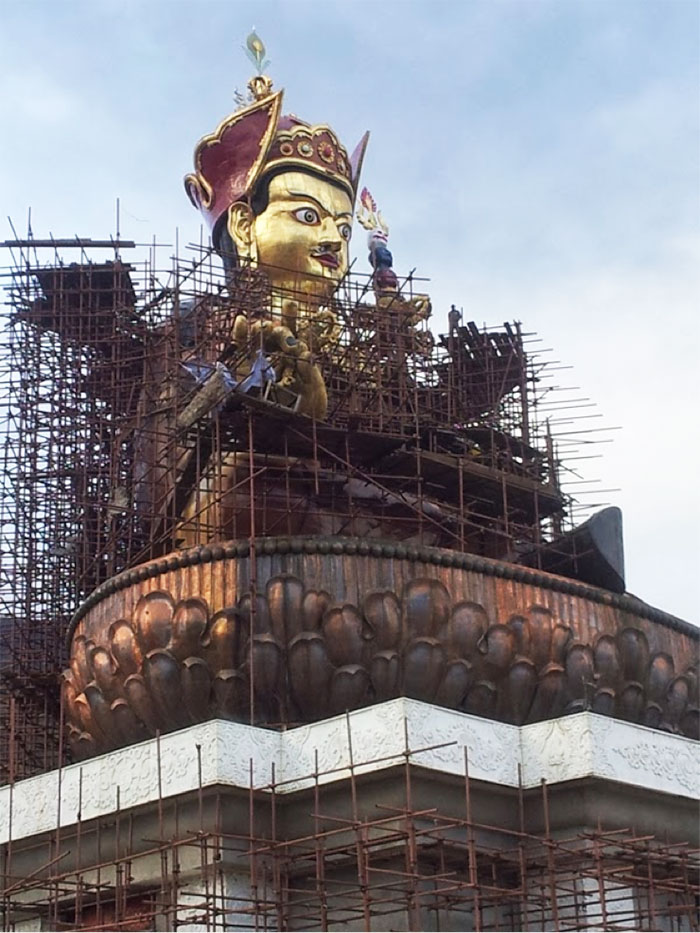Therefore, the establishment of the Engineering Council of Bhutan is a significant step for the construction industry. One hopes that it will complement the Bhutan Standard Bureau, Bhutanese Institute of Architects and Construction Board of Bhutan but a bureaucratic hurdle. Above all, one hopes it will tackle some of the challenges facing the engineering profession.
God is in the Details- Will the new Council tackle the issues of Fake Signatures, Audit Memos and Engineering Research Deficiency Disease in Bhutan?

Guru statue at Takila, Lhuentse
Engineers and fake signatures
One of the biggest challenges the council will face will be to address the issue of engineers and fake signatures. The issue has become a moral virus in a small society like Bhutan. If the foundation pads and steel reinforcement details in our buildings could speak, they would reveal the true identity of the actual designer (mostly working in a government agency) and the fake signature in many of our major engineering projects, including the countless residential buildings. The moduli of operation are as simple as this: The engineering firms submit a resume of experienced engineers to score high on the technical tender evaluation and get the work because the evaluation team will only see the documents and the generally fake “all good” recommendation letters from past projects and clients. Once the work is won, the design is given to a fresh engineer working in the office and the experienced engineers blindly sign the drawings even without looking or checking. The result: thicker bottom chord of a steel roof truss has become the top chord and vice versa, our pedestrian bridges have load carrying capacity of a running train and our large sporting halls have no ventilation, our projects are inaugurated with the colourful ceremony but they are not functional, the irrigation channels don’t functions and the lists go on.
A district engineer expressed his surprise that all the drawings his office received were signed by the same designer and there was no correlation between different drawings for the same project. Rampant copy and paste for quick money, underquoting and survival of the cheapest are the hard lessons of the times. One hopes the council will eradicate such a professional pandemic which is costing the public, profession, and the country dearly.
Engineers and audit memos
The annual audit report is often regarded as the tiger document for the public servants. It is not a coincidence that most of the dreaded audit memos have been against engineers, particularly the site engineers. Our site engineers slog day in and day out in sun and rain managing corrupt contractors at the site while clever bosses chat away in social media in their executive offices. If a work order comes to a chief engineer, they are typically passed with ” necessary action please“ to the next subordinate cubicle or section. This effectively passes the accountability and audit for any lapses are mostly on the site engineer. If a document regarding training comes then it is passed to the site engineers only if the bosses are ineligible to go for it. This results in the site enginees working in remote sites getting all the audit memos and the chief engineers at head offices taking all the training. This has a demoralising impact. The alarming number of audit memo against the site engineers also makes one wonder if other sectors are super clean. Our site engineers are like the frontline health workers for our infrastructure projects. One hopes that the engineering council will be able to investigate these issues through research for the way forward.
Engineers and Academic research
The journey of modern Bhutan is incomplete without the work of the engineers. Bhutan would be still a backward nation if not for the roads, bridges, hydropower and telecom and infrastructure projects designed and built on some of the most challenging terrains. Projects like the Thimphu-Phuentsholng highway and rock-cut section between Tanalung and Bunakha deserve a special mention. Our hydropower projects are built in some of the most challenging terrains, so are our modern dzongs and world’s tallest Buddha and Guru Rinpoche statues. If the Royal Thimphu College had been built elsewhere there would have been a book published on its concept, design and construction. Same goes with so many of our modern infrastructure projects like the Amochu Township and other institutions under construction. But, sadly, none of these significant projects has been documented and published as a well-researched book. We make investments of billions of ngultrums in engineering projects, consultancy fees and hardly anything to document them and publish their journey. Academicians and researchers cannot sustain with passion and interest alone. They need financial support. Is it possible to allocate 5-10 percent of the budget from each of the national projects for the technical institutions and academicians to compile a well-researched book? How about having a book on the concept design and construction of the world tallest Buddha and Guru statues? It will be academic poverty for modern Bhutan if we fail to compile a monograph on modern Bhutanese Dzongs like Chukha, Tsirang, Pemagatshel, and Sarpang.
One hopes that the government will have the wisdom to support such a move and the Bhutan Engineering Council will collaborate with the Royal University of Bhutan to document and educate and reinforce the future engineers.
Contributed by
Dhrubaraj Sharma
QUT Design Lab

